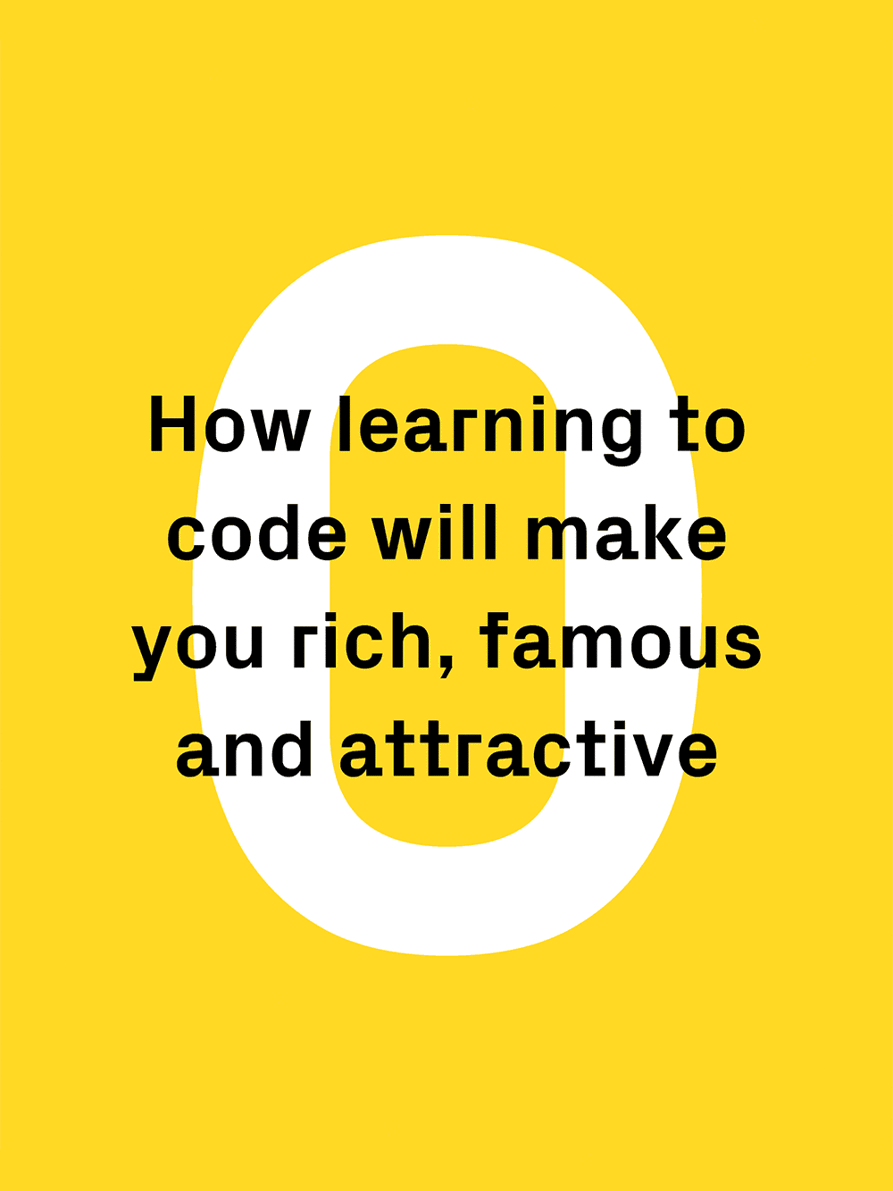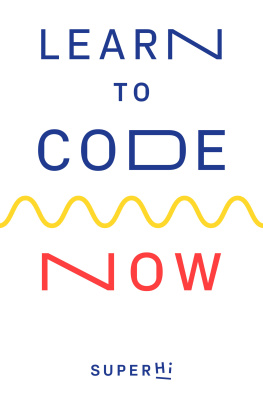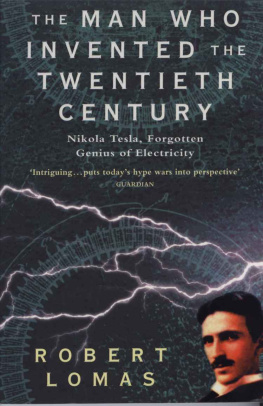Rik Lomas - Learn to Code Now
Here you can read online Rik Lomas - Learn to Code Now full text of the book (entire story) in english for free. Download pdf and epub, get meaning, cover and reviews about this ebook. year: 2017, genre: Home and family. Description of the work, (preface) as well as reviews are available. Best literature library LitArk.com created for fans of good reading and offers a wide selection of genres:
Romance novel
Science fiction
Adventure
Detective
Science
History
Home and family
Prose
Art
Politics
Computer
Non-fiction
Religion
Business
Children
Humor
Choose a favorite category and find really read worthwhile books. Enjoy immersion in the world of imagination, feel the emotions of the characters or learn something new for yourself, make an fascinating discovery.
- Book:Learn to Code Now
- Author:
- Genre:
- Year:2017
- Rating:5 / 5
- Favourites:Add to favourites
- Your mark:
- 100
- 1
- 2
- 3
- 4
- 5
Learn to Code Now: summary, description and annotation
We offer to read an annotation, description, summary or preface (depends on what the author of the book "Learn to Code Now" wrote himself). If you haven't found the necessary information about the book — write in the comments, we will try to find it.
Learn to Code Now — read online for free the complete book (whole text) full work
Below is the text of the book, divided by pages. System saving the place of the last page read, allows you to conveniently read the book "Learn to Code Now" online for free, without having to search again every time where you left off. Put a bookmark, and you can go to the page where you finished reading at any time.
Font size:
Interval:
Bookmark:
Learn to Code Now
Written by
Rik Lomas
Foreword by
Frank Chimero
Art Direction by
Milan Moffatt
Thanks to
Holly Holmes
Christine Lomas
Lawrence Gosset
Adam Oskwarek
David Holmes
Simon Whybray
Deron Millay
The team at Koto
Tony the cat for his furry cuddles
NYU Langone Medical Centers caf
Projective Space, Lower East Side, NYC
Tim Berners-Lee for making the web
All our students for supporting us
2017 SuperHi Inc.
CONTENTS
Code snippets are best viewed in landscape mode

Foreword
by Frank Chimero
The house where I was raised was an ideal place for our family, except for one serious flaw: the house did not have my parents fingerprints on it. So began a constant construction project that lasted almost a decade. Bathrooms were moved and walls knocked down; skylights were installed, had their leaks fixed, then uninstalled for the trouble they caused. My parents removed the attic, raised the ceilings, bought a larger Christmas tree to take advantage of the new vertical clearance, then celebrated the New Year by re-tiling the bathrooms.
One day after arriving home from school, I saw my father hovering over a giant stockpot with wooden strips fanned out over the rim like uncooked spaghetti. He was boiling the planks, he said, to soften them. Hed then slowly form each strip along the curved edge of our built-in bookshelf to use as trim for the semi-circular shelves at the end. My father was taught this method by my grandfather, another amateur furniture maker, and now it was my turn to learn the process. Pay attention to the wood, follow the grain, and if you take care, the wood will bend and not break, he said. This was clearly intended to be a life lesson as well as a lecture in woodworking, the kind of practical inheritance that fathers like to provide their sons. Be patient. Be gentle. Got it.
Carpentry didnt take. Ten years of growing up in a construction zone made me swear off woodworking. (Also, we got a computer the year after my lessons in woodwork. How could I resist?) Instead I design and build software, which has its own methods and tricks, but I still find myself returning to my dads lesson. All materials, whether wood or pixels, have a grain, and that grain suggests the best way to work. Go with the grain and one will find sturdiness combined with tremendous flexibility a natural and exciting give that grounds decisions and excites with possibilities. Work against the grain and the work becomes precarious, difficult and fragile. Instead of the elegant bending that software requires to adjust to different screens, uses, and situations, the work breaks because it cannot adapt.
This idea of a grain, however, flies in the face of our expectations for technology. Software is often presented as a wide-open, infinitely malleable material. We expect technology to help us overcome limitations, not produce more of them. Cant I do what I want? Only to an extent.
We use teak for outdoor furniture because it is weather resistant. We use white pine for wood carving because it is soft. These kinds of rationale also go for designing software. On screen, we use flat colors and simple gradients, because theyre lightweight, easy to programatically draw, and can scale for areas of varying proportions. Sites have horizontal stripes of content stacked vertically, because that is how we read, and it is easier for most users to scroll vertically than horizontally. All of these design choices come from a knowledge of the materials at hand. What is the grain of software? It has to do with fluidity. People who work on software create flexible systems that can deal with variability: content of varying lengths, connections of different speeds, users with many kinds of ability and attention span. What does the page look like if it is empty? If it is full? And every possibility in between on a mobile device? Working with software is never designing towards a fixed artifact like a chair or book. Instead, it is defining and designing conditions for a whole set of possibilities.
The easiest way to explore and test these possibilities is by working with the raw materials themselves. Learn a bit of code and fiddle with things. A sturdy knowledge of HTML, CSS and Javascript goes a long way towards understanding what is possible with the medium.
Good work is grounded in attention to detail, and knowledge of and respect for the materials.
You will make mistakes. Things wont work. But you will be in good company. We all get it wrong on the first, second, even third tries, no matter how much experience we have. Getting your hands on the materials is a learning process for all of us. We feel the grain and discover the contours of the problem we are to solving, and revise when our efforts dont work quite as expected. Luckily, code and pixels are free, so your trials and errors should be less expensive than the considerable amount of lumber Id waste if I ever took up woodworking.
My father never fully understood what I did for a living, but we could always find common ground in craftsmanship. Good work is grounded in attention to detail, and knowledge of and respect for the materials. The more experience I gain, the more this proves itself. Pay attention, respect the material, listen to how it guides you, and be gentle. Youll be surprised by what you can do and how flexible it all can be.
Frank Chimero, 2017

and how to avoid the fake promises every single article on the internet on learning to code tells you.
Articles about learning to code often describe the possible financial rewards. How this knowledge will earn you a better salary, a promotion, even a new job.
There is some truth in these claims. Weve taught people whove gone on to get pay rises, improved careers and higher freelance rates. Thats because good coders are in demand.
A likely skills shortage in the next decade means a lot of jobs wont be filled. Some estimates suggest there will be a million vacancies in technology by 2020 in the United States alone.
At the same time more and more traditional jobs are set to be automated. Driverless cars for instance will likely become mainstream over the next two decades, threatening to put 3 million Americans out of work.
So theres a problem. Artificial Intelligence could lead to mass unemployment at the same time as tech jobs cant be filled due to the lack of a skilled workforce.
For children of course its different. There are nine year olds in Estonia learning to program as part of their school curriculum. A group called Code Club holds after-school sessions around the world.
Sounds scary, right? Millions of jobs worldwide taken by robots, millions of jobs unfulfilled and nine year olds who can code better than you. The articles tell us to learn how to code so we are on the right side of this shift and wont be left behind. Often it can work. Weve seen people whove paid five-figure sums to go on boot camp-style courses because theyre worried about their future. But our approach is different. Were here to say dont become a coder. Dont learn to code just to be a coder.
We know what youre thinking. Why is a code school telling me not to study coding?
Were not. Were saying you should learn to code to improve and add to the skill set you have. If youre a designer, for instance, learning to code will give you a better understanding of how to design for the web. Keep being a designer, but one who knows how to use media queries in CSS to change a layout for mobile screens.
Next pageFont size:
Interval:
Bookmark:
Similar books «Learn to Code Now»
Look at similar books to Learn to Code Now. We have selected literature similar in name and meaning in the hope of providing readers with more options to find new, interesting, not yet read works.
Discussion, reviews of the book Learn to Code Now and just readers' own opinions. Leave your comments, write what you think about the work, its meaning or the main characters. Specify what exactly you liked and what you didn't like, and why you think so.











